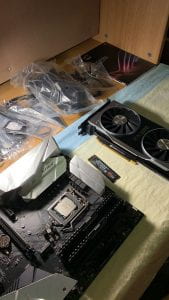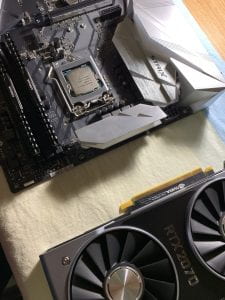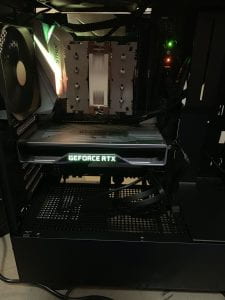Just like how human bodies work, computers are intricate machines which contain different functional unit but they together work with each other as a system to achieve one purpose.
A system can involve human factors, but it can also follow a pre-build program to run by itself. I recently witness how this magnificent system works by assembling my first P.C.
A system needs to have elements which can carry out different functions, so I began my P.C. assemble process by listing all the units that I want to make it works. If trace back in time to the 70s, the main body of my computer will take up space around twice as big as my current apartment. Luckily, with the burgeoning of technology, the replacement of this unite is a book-sized electronic panel, called “motherboard”. On the motherboard, there are countless of small rectangular bumps that are very tidily sealed on the surface. This tiny unite is called “diode”, and it function as valves in human body, which only allows blood to stream in one direction. That is also the very basic unite that forms a CPU (Central Processing Unit). There are billions of diodes tessellated with each other in a one by one square inch silicon plate, and they together made up the brain of the computer system which is located at the center of the motherboard. If we move our sight a little downward, there are some parallel empty slots. Those slots are called PCLe which is specifically designed to connect GPU(Graphics Processing Unit). If a computer system is compared with a factory, CPU acts like the director of the factory who gives orders about what workers are going to make, then the GPU is the whole assembly line. It translates all the machine code to human-readable visual signals. To make the system complete, there are also memories and hard drives that shoulder the responsibility of containing data, and a power supply that can consistently supply electricity to the system.
A computer is a very complex and precise system, that means any unplanned changes to the system will immediately result in system failure. The tiny electricity wires that are intensively sorted on the motherboard are equivalent to the blood vessel system in the human body if compare human with the computer. However, the blood vessels in the computer are way more advanced. Blood in the human body only carries nutrition and oxygen and act as a power supply. The electronic wires that are sorted on the motherboard also carries signals. The signal in a computer system is in the form of electromagnetic waves. They travel in light speed in the vessel, and it will give instant feedback to any new things that trying to enter or interrupt the system. They together hold up the system, but also make the computer system very fragile and sensitive. However, there is another factor that slowly affects the whole system, and that is part of the physical law which human beings cannot fully overcome with- the heat. It could be also described as the waste in the computer metabolism. Multiple cooling fans need to be installed to prevent the computer from overheating.
The purpose of a computer system is simple, which is to process digital files and undergoes computation then visualize everything to the user. At the beginning of the computation process, the power supply has to be initiated. The power supply gives every component electricity, so it only has one-way interaction with other computer components. Which means other components cannot affect this unit. Then, all the data is stored in the hard drive, that include the user data, and the system data, The system data is first sent to a good friend of hard drives- memory unite. A memory unit is a much smaller but much faster hard drive that allows CPU to quickly get access to the data. Before the computation starts, every piece of data will go through the memory unit. After the software system is fired up, our CPU tells GPU to load our start screen wallpaper. Also, it sends a signal to all the peripherals such as the keyboard and mouse to get them ready for user interaction.





